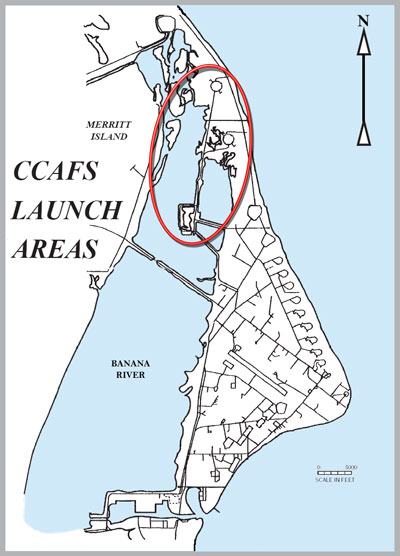
Photo Gallery
History
As a result of a 1961 study by the Large Launch Vehicle Planning Group, consisting of representatives of both the Department of Defense and NASA, the Titan III was born.
There were three major objectives the Air Force was looking for in the research and development phases of the Titan III:
- Flight testing of large solid propellant motors married to a liquid rocket.
- Transtage giving the nation an engine stop-start capability in space.
- Integrate-Transfer-Launch (ITL) concept.
The Titan III ITL facility and ground equipment were designed to provide a number of advances over previous space launch systems. These included: quick reaction time, space booster configuration flexibility, capability to accommodate a multitude of payloads without extensive systems and facilities tailored for varying payloads, and increased rates of vehicle launching.
The ITL Complex
The ITL was built on landfill and three man-made islands in the Banana River adjacent to Cape Canaveral. To construct the island chain, 6.5 million cubic yards of fill was dredged from the river.
Separate components that made up the ITL were the 19.9-mile Rail System, Segment Arrival Storage Area, Receipt Inspection Building, Motor Inert-Components Storage Building, Segment Ready Storage Building, Vertical Integration Building, Solid Motor Assembly Building, Transporter System, and Launch Complexes 40 and 41.
The Titan IIIA (core vehicle) components were received, inspected, erected and checked out in the Vertical Integration Building (VIB). Payloads could also be mated with the core vehicle while in the VIB. The core was erected on a mobile transporter/thrust mount which could be moved from one area of the ITL to another by means of a double-track railroad system.
In the original design concept, if the mission required a Titan IIIC booster, the completely checked out core vehicle was moved to the Solid Motor Assembly Building (SMAB) where two solid rocket motors were attached. The completed vehicle was then moved to one of the two launch pads were it was readied for launch approximately five days later.
The Centaur upper stage, developed by NASA’s Lewis Research Center, was integrated with the Titan III to launch Viking spacecraft to Mars in 1975. The Titan/Centaur combination was also used to boost heavy payloads into Earth orbit and onto interplanetary trajectories.
The ITL was modified over the years to accommodate ever larger launch vehicles, such as the Titan IIIE, Titan 34D, and Titan IV.


